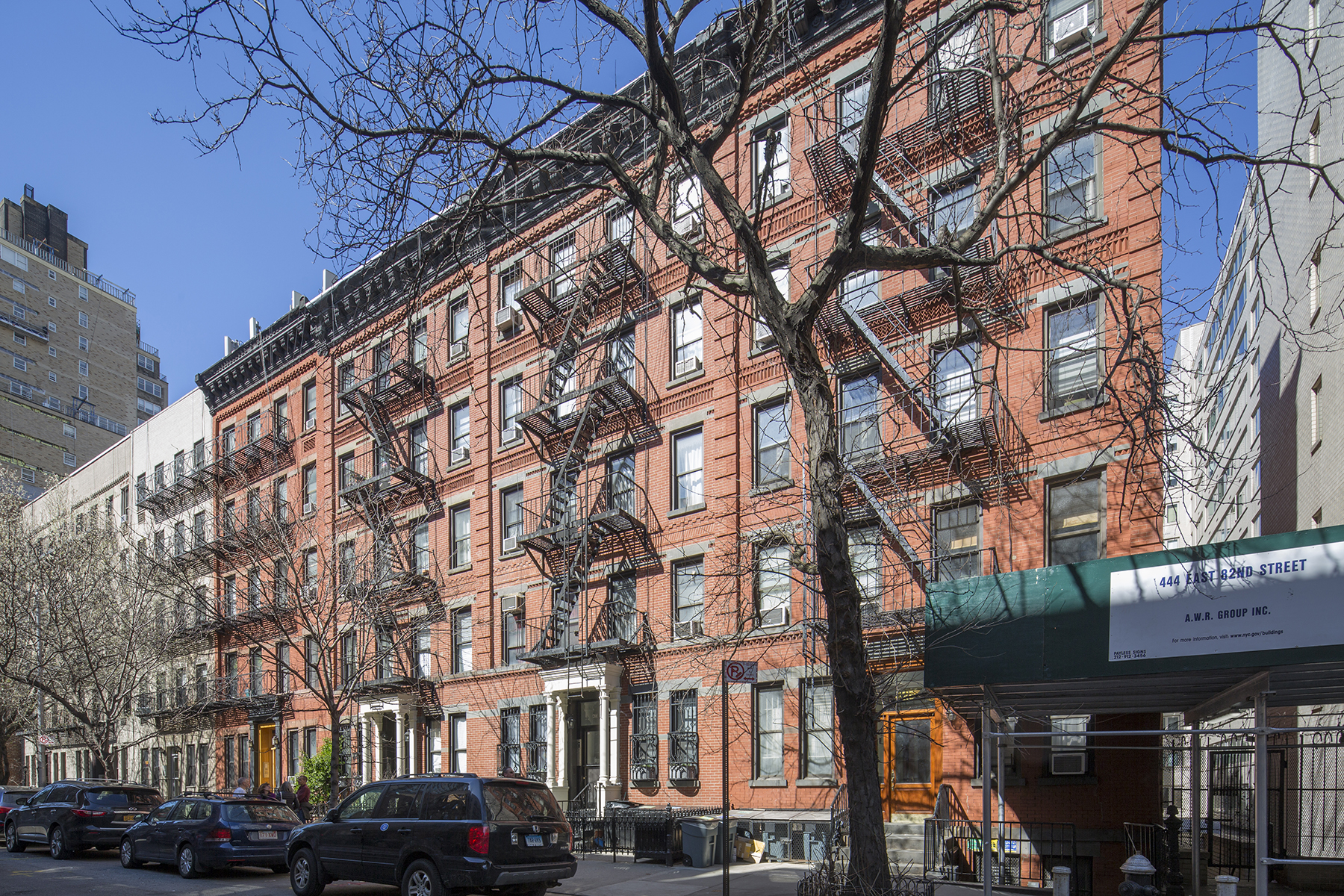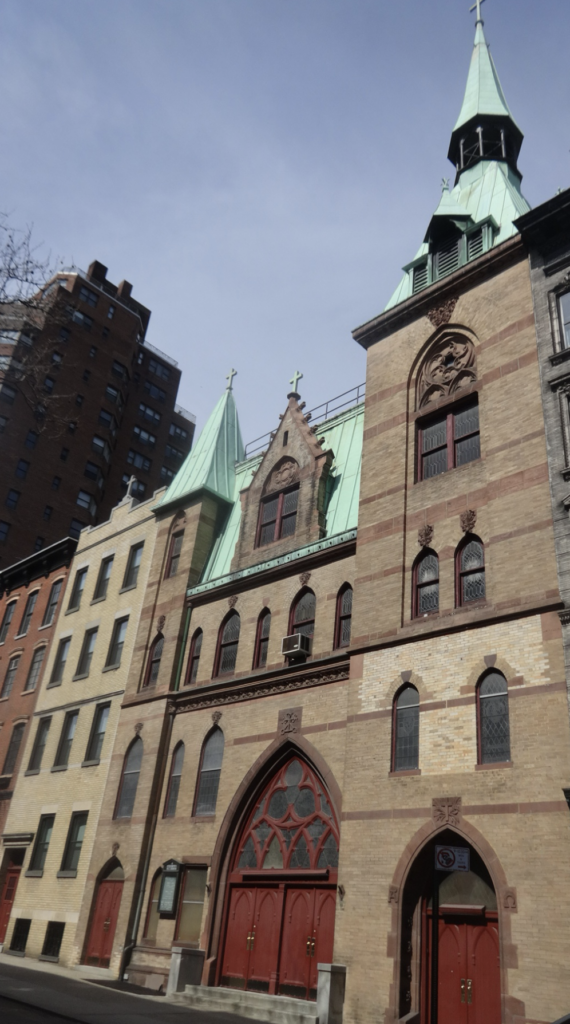
Yorkville tenements
Yorkville History
Yorkville, on the eastern side of the Upper East Side, has a rich history as a vibrant immigrant community. It began as a small village around the intersection of 86th Street and the Boston Post Road (now Third Avenue), a vital postal route between Boston and New York City. Throughout the 19th century, Yorkville welcomed waves of immigrants, starting with the Irish and Germans and later joined by Czechs, Slovaks, Hungarians, and others. This diverse community shaped the neighborhood's character, evident in its religious, cultural, and commercial buildings. The heart of Yorkville's immigrant story lies in its affordable housing: hundreds of low-rise tenements that lined its quiet streets. The U.S. Census records offer a glimpse into tenement life, revealing a rich tapestry of families from different ethnic backgrounds often sharing the same roof. For example, the 1900 census reported that a typical tenement building at 414 East 73rd Street housed 18 families with a total of 80 residents.

414 East 73 Street (1940s Tax Department photographs, New York Department of Finance)
Yorkville Today: High-Rises vs. History & Affordability
Today is home to a diverse range of housing, including a significant amount of rent-stabilized and regulated apartments, much of it in its historic, low-rise tenements on both its avenues and its sidestreets.
However, this neighborhood is particularly vulnerable to the loss of affordable housing, partly due to its lack of historic district designation. Without this added protection, Yorkville faces rampant demolition and redevelopment, leading to a net loss of affordable units.
A 2015 report by FRIENDS highlighted this issue, revealing that Manhattan Community Board 8 (which includes Yorkville) experienced a 26% net loss of affordable units between 2007 and 2014. This is compared to a citywide loss of just 6%. During this period, 1,578 buildings in the area lost rent-stabilized units, with 70% of these losses concentrated east of Third Avenue in neighborhoods like Lenox Hill and Yorkville. A 2022 report by FRIENDS found that large swaths of relatively affordable, low-scale tenement buildings were being replaced by tall luxury buildings at an alarming rate. But the loss goes beyond historic fabric. These new buildings are often 210+ feet tall with fewer than 15 apartments each. The same building envelopes could have accommodated many more reasonably-sized units, representing a significant loss in potential housing density. Beyond certain loopholes that skirt the intent of zoning regulations and are used to artificially inflate building height, unit sizes themselves are also growing, even on Madison Avenue despite the existing height limit.
More recently, Upper East Side lost a shocking number of 14,438 units between 2007 and 2020, as illustrated by zoning expert George Janes in his May 29th presentation on City of Yes for Housing Opportunity.

George M. Janes & Associates, Changes in Rent Stabilized Housing in Manhattan & Community District 8, draft report, 6/29/2020
There are many reasons behind this. Small tenement buildings are being torn down throughout the Manhattan core, including the Upper East Side. They are then replaced with tall, luxury tall buildings, which developers are able to build ever taller by finding numerous novel workarounds to circumvent the limitations put in place by zoning regulations. The loss of these buildings further strains affordability. In addition, the conversion of row houses from multiple apartments back to single-family homes are resulting in even more unit losses. The result, according to the map below, is that neighborhoods like ours have been hemorrhaging housing units (both affordable and market-rate), even though there is considerable construction activity.

This map shows the changes in housing unit loss on the Upper East Side, Upper West Side, and West Village.
Today, the loss of affordable housing due to luxury development is more acute. Here is a more recent case study of affordable housing unit loss from Yorkville: Two new tall buildings are under construction on the south corners of 83rd Street and Second Avenue. On the southeast corner, three historic tenement buildings were demolished to make way for a 22-story condominium building with 70 units. On the southwest corner, six buildings were demolished to build a 31-story luxury rental building with 128 units. A total of 51 affordable housing units along with ground-floor small businesses were lost just at this intersection.
Developers could take advantage of the MIH (Mandatory Inclusionary Housing) incentive to build even taller but they do not have to build these affordable units on site. Instead while they build taller luxury towers in Yorkville, they build affordable units in Roosevelt Island or the Bronx.
Today, Yorkville stands as a stark reminder of the challenges facing our cities. The neighborhood's affordability crisis threatens to unravel its rich fabric. As housing costs rise and development pressures intensify, communities like Yorkville are at risk of losing their unique character and cultural heritage. To preserve this invaluable cultural heritage, we must prioritize affordable housing initiatives. While FRIENDS firmly believes that the city is in desperate need of more affordable housing, these new luxury towers are not it, and in most cases they are displacing relatively affordable units as well as the small businesses which thrive in the bases of these century-old structures.
Yorkville RFEs
Yorkville boasts a wealth of architecturally distinctive buildings reflecting our cultural heritage and worthy of landmark designation. FRIENDS of the Upper East Side Historic Districts has been actively advocating for the protection of these significant structures. Over the past years, we have submitted 38 Requests for Evaluation (RFE) proposing individual landmark status for key buildings in Yorkville and Lenox Hill.
Many of these buildings are integral to Yorkville’s history as a welcoming enclave for European immigrants, particularly from Germany, Hungary, Czech Republic, and Ireland. For example, the distinctive Italianate-style Kaiser and The Rhine apartments at 1716 Second Avenue stand as a testament to the German-American community’s growth during the late 19th century. The Doelger Building with its arresting Art Deco façade with terracotta ornamentation housed offices and storefronts, and a music hall that was once used by the Irish community. In addition, there are numerous distinctive and architecturally significant churches that served the many different congregations and communities in the area. Much of this unique heritage remains without the protections of landmark designation.
These buildings symbolize the diverse histories of this corner of New York City. Their varied original uses and architectural styles represent the unique character of Yorkville. Beyond their cultural significance, other buildings in Yorkville have served vital community functions, such as education and healthcare. P.S. 158 (1458 York Avenue), designed by renowned architect C.B.J. Snyder, embodies the progressive educational ideals of its era. The New York Psychoanalytic Society & Institute (247 East 82nd Street) stands as a reminder of the neighborhood’s pioneering role in mental health treatment.
This diverse collection of structures, with their varied architectural styles and historical significance, represents the unique character of Yorkville. They are a testament to the neighborhood’s rich history and cultural tapestry. Here are three of the exceptional buildings highlighted in this article:

Saint Elizabeth of Hungary
The Church of St. Elizabeth of Hungary (213-215 East 83rd Street), designed in the Gothic Revival style by Henry F. Erhardt and built in 1893, has a fascinating history. Originally built for a German Lutheran congregation, it later served as the home of the city’s oldest Slovak parish. It ministered to a diverse Catholic community and was known for its outreach to the deaf. This remarkable building, with its architectural beauty and historical significance, deserves landmark status yet the future of the beloved Church of St. Elizabeth of Hungary is in jeopardy. Faced with potential de-consecration and redevelopment, this beloved Yorkville landmark risks erasure from the neighborhood’s rich urban fabric. Yet, its imposing architecture and prime location offer a unique opportunity for adaptive reuse. By preserving its distinctive character while embracing new functions, this iconic building can remain a cornerstone of the community, honoring its role in shaping Yorkville’s immigrant heritage. FRIENDS urgently appealed to the Landmarks Commission at the end of July to protect Yorkville’s architectural and cultural heritage by proposing individual landmark designation for the Church through a Request for Evaluation.

The Doelger Building
The Doelger Building (1491 Third Avenue), also known as the Mayo Ballroom, is another architectural gem. The building was built in 1930 and owned by Peter Doelger Inc., a brewery-turned-real estate investment company founded by German immigrant brothers. The Doelger Building has served the Yorkville community as a ballroom and event space and was likely a popular gathering spot for residents of “Little Germany.” In addition, the building has served as retail and office space for numerous businesses over the years, while still retaining its original exterior appearance. The Doelger Building’s history of varied tenants and uses, coupled with its unique Art Deco façade, should be preserved and protected through individual landmark status.

The Manhattan building
Last one is the Manhattan building (244 East 86th Street). The building was constructed in 1879 for the Rhinelander Real Estate Company, one of the early prominent developer families in the Yorkville area and designed by Charles W. Clinton. The Manhattan is significant for its association with the Rhinelander family, as an early example of an apartment building which aimed to provide homes that were a step up from crowded, stuffy tenement dwellings, and for its role in the development of the Yorkville area. The design and program for the building are indicative of a moment in the housing history of New York City. For these reasons, the Manhattan is eligible for designation as an individual landmark.
Preserving these architectural treasures is essential to safeguarding Yorkville’s unique identity and cultural heritage. We urge you to join us in advocating for the landmark designation of these remarkable buildings.

